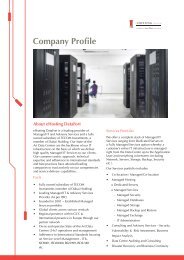Connecting with Cloud by eHDF
a valuable heated debate by eHDF
a valuable heated debate by eHDF
You also want an ePaper? Increase the reach of your titles
YUMPU automatically turns print PDFs into web optimized ePapers that Google loves.
CLOUD COMPUTING<br />
58
CLOUD COMPUTING<br />
CONNECTING<br />
WITH<br />
Private cloud<br />
deployments,<br />
where<br />
organisations<br />
create internal<br />
cloud resources<br />
for use solely <strong>by</strong><br />
their own users<br />
are increasing.<br />
THE CLOUD<br />
ADOPTION OF CLOUD COMPUTING IN THE MIDDLE<br />
EAST IS FINALLY TAKING OFF, AS ORGANISATIONS<br />
LOOK TO PRIVATE CLOUD PROJECTS BASED<br />
ON THE FOUNDATIONS OF VIRTUALISED<br />
INFRASTRUCTURE TO DELIVER MORE FLEXIBLE<br />
AND MORE EFFICIENT COMPUTING RESOURCES TO<br />
THEIR BUSINESS USERS<br />
BY KERI ALLAN<br />
May 2013 ARABIAN COMPUTER NEWS 59
CLOUD COMPUTING<br />
Abraham: Cost and<br />
scalability benefits<br />
are driving private<br />
cloud adoption.<br />
hen it comes to cloud<br />
technology, the<br />
landscape is changing<br />
across the Middle<br />
East. Organisations<br />
all over the GCC are<br />
seeing the significant<br />
inroads cloud is making<br />
globally, and are<br />
beginning to embrace<br />
it, <strong>with</strong> analysts expecting<br />
heavy uptake<br />
to take place over the<br />
next four years.<br />
“Private cloud<br />
solutions will show<br />
strong growth driven<br />
<strong>by</strong> the benefits of<br />
cost and scalability,”<br />
says Rajesh Abraham, director, Product Development, eHosting<br />
DataFort. “According to industry research, in 2013, cloud services<br />
in MENA are expected to grow rapidly in some countries, specifically<br />
Saudi Arabia (43%) and UAE (40%).”<br />
For many enterprises, the solutions they’re focusing on are<br />
around private cloud; in part due to a lack of public cloud providers<br />
but also security and data privacy concerns. Plus, <strong>with</strong> the fact<br />
that many enterprises in the Middle East have already embraced<br />
IT infrastructure virtualisation, they are well positioned to deploy<br />
private cloud.<br />
“Companies are increasingly aware that private cloud technology<br />
goes beyond virtualisation, hence the adoption is starting to<br />
increase rapidly. The uptake of private cloud in the Middle East is<br />
‘patchy’ however, which means that in each industry – such as oil<br />
and gas, healthcare, or finance - there are some organisations completely<br />
adopting private cloud technology, while others are still<br />
evaluating whether it is the best fit for them,” notes Kevin Harris,<br />
enterprise technologist, <strong>Cloud</strong> Computing, at Dell EMEA Emerging<br />
Markets.<br />
“This growing interest in cloud, especially private cloud, has<br />
contributed to the large-scale adoption of virtualisation we’ve<br />
seen across the UAE,” adds Sony John, research manager for IT<br />
services at IDC Middle East, Africa, and Turkey. “However, only<br />
a handful of organisations have gone the full distance in terms of<br />
converting these highly virtualised environments to fully-fledged<br />
private cloud deployments. This is due to a variety of factors,<br />
including general misconceptions around the two concepts, and a<br />
lack of clarity on the benefits of going for a fully automated, fully<br />
metered private cloud.”<br />
Indeed there is some confusion as to what exactly a private<br />
cloud solution is, as Meera Kaul, managing director of Optimus<br />
highlights. Here she explains what a true private cloud environment<br />
should entail.<br />
“COMPANIES ARE INCREAS-<br />
INGLY AWARE THAT PRIVATE<br />
CLOUD TECHNOLOGY GOES BE-<br />
YOND VIRTUALISATION, HENCE<br />
THE ADOPTION IS STARTING<br />
TO INCREASE RAPIDLY.”<br />
60 ARABIAN COMPUTER NEWS May 2013
CLOUD COMPUTING<br />
Virtualisation is not<br />
private cloud, and<br />
uptake is not clear,<br />
says Kaul.<br />
Rao: Solutions to<br />
help companies roll<br />
out private cloud are<br />
coming to the fore.<br />
THREE STEPS TO SECURING YOUR CLOUD<br />
1. Define a cloud strategy <strong>with</strong> security in mind<br />
Identify the different workloads and how they need to interact. Which<br />
models are appropriate based on their security and trust requirements and<br />
the systems they need to interface to?<br />
2. Identify the security measures needed<br />
Using a framework allows teams to capture the measures that are needed in<br />
areas such as governance, architecture, applications and assurance.<br />
3. Enabling security for the cloud<br />
Understand the upfront set of assurance measures you will want to take, and<br />
assess that the applications, infrastructure and other elements meet your<br />
security requirements, as well as operational security measures.<br />
“There is no actual data [on private cloud uptake] except<br />
claims <strong>by</strong> vendors that they have sold cloud solutions into the<br />
regional market. These are mostly instances of on-premise implementations<br />
of virtualised environments,” she says.<br />
“A virtual environment is not a cloud implementation unless it<br />
caters to a resource orchestration and automation layer on top of<br />
the virtualised environment. Most times, instances of cloud washing<br />
are claimed as instances of private cloud. However, these are<br />
mostly just highly architected virtualised environments that are<br />
not essentially cloud as they only cater to one specific characteristic<br />
of a private cloud infrastructure, vis scalability and high levels<br />
of utilisation.<br />
“Self-provisioning <strong>by</strong> users, infinite capacity on demand,<br />
shared resources and pooled capacity and ability to pay for use<br />
<strong>with</strong> no commitment may not be present. In absence of these<br />
features, these deployments may not be classified as private cloud<br />
environments,” she states.<br />
Vendors will always aim to offer a variety of solutions in order<br />
to meet wider industry needs, so what are some of the main private<br />
cloud solutions on the market right now?<br />
“GBM offers a private cloud solution based on IBM Smart-<br />
<strong>Cloud</strong> Foundation, which is a family of technologies designed to<br />
help organisations quickly adopt private cloud,” says Pappu Rao<br />
TS & technical support services director, Gulf Business Machines.<br />
“It enables virtualisation, consolidation, automation and management<br />
of service delivery. IBM dynamic scheduling and provisioning<br />
capabilities can deploy dozens of virtual machines in a few<br />
minutes. GBM also offers a private cloud solution based on VMware<br />
v<strong>Cloud</strong> Suite. VMware v<strong>Cloud</strong> Director leverages vSphere<br />
technology to deliver cloud computing. It supports a multi-tenant<br />
environment and provides a self-service portal to provision virtual<br />
resources including server, storage and networking.”<br />
eHosting DataFort’s (<strong>eHDF</strong>) managed private cloud solutions<br />
are targeted towards medium to large enterprises looking at enhanced<br />
and dynamic utilisation of existing infrastructure/applications<br />
in terms of scalability, elasticity and faster time to market.<br />
“In addition to facilitating shared<br />
resources and reduced investments<br />
on hardware, the services will allow<br />
companies to buy capacity-based options<br />
rather than making purchases based on<br />
set specifications — a key imperative for<br />
growing businesses as they move online<br />
and require rapid provisioning,” says<br />
Abraham. “<strong>eHDF</strong> is responsible for implementing<br />
the first private cloud in the<br />
UAE to EMCOR Facilities Services, an<br />
integrated facilities management service,<br />
operation and maintenance solution provider<br />
in the Middle East, North Africa,<br />
and South Asia region. At present <strong>eHDF</strong><br />
is hosting its main business application<br />
Source: IBM<br />
May 2013 ARABIAN COMPUTER NEWS 61
CLOUD COMPUTING<br />
“THERE IS NO ACTUAL DATA [ON PRIVATE CLOUD UPTAKE] EXCEPT<br />
CLAIMS BY VENDORS THAT THEY HAVE SOLD CLOUD SOLUTIONS<br />
INTO THE REGIONAL MARKET. THESE ARE MOSTLY INSTANCES OF<br />
ON-PREMISE IMPLEMENTATIONS OF VIRTUALISED ENVIRONMENTS.”<br />
suite, the Oracle JD EnterpriseOne, which being a Tier-1 application<br />
required a competent technology delivery platform.”<br />
“EFS was looking to migrate to a model where investment was<br />
required only in core infrastructure, while the rest was shifted to a<br />
lease model. This strategy was essential as it allowed EFS to focus<br />
on future investments in people, processes and applications. In the<br />
project, one of the most important elements EFS benefited from<br />
was the service provider’s strategy to deploy a qualified team for<br />
the project. EFS was able to consolidate infrastructure, integrate<br />
all disparate systems and create a centralised infrastructure model<br />
that embraces service oriented architecture, coupled <strong>with</strong> governance<br />
models and industry best practices, all encapsulated into a<br />
new high availability data centre to ensure business continuity of<br />
information technology,” Abraham continues.<br />
“In addition EFS has seen benefits including standardised<br />
business processes, data loss prevention, organisational wide<br />
BENEFITS OF CLOUD<br />
A survey of 700 IT professionals conducted <strong>by</strong> Toluna and Qumu identified the<br />
following benefits of cloud computing:<br />
25%<br />
20%<br />
15%<br />
10%<br />
5%<br />
SECURITY<br />
COST SAV-<br />
INGS ONCE<br />
DEPLOYED<br />
BETTER<br />
MOBILITY<br />
SUPPORT<br />
TIME SAVED<br />
NOT HAVING<br />
TO UPDATE<br />
QUICK<br />
DEPLOY-<br />
MENT<br />
BETTER<br />
FOR ENVI-<br />
RONMENT<br />
ELASTICITY<br />
TO SCALE UP<br />
OR DOWN<br />
OUT-<br />
SOURCED<br />
SUPPORT<br />
security, pro-activeness to client requirements and agile solutions,<br />
meeting SLA and compliance requirements, and automated<br />
backup to ensure data resiliency and redundancy.”<br />
Clearly a private cloud solution offers many benefits. It provides<br />
organisations <strong>with</strong> greater control and security, and at the<br />
same time gives them the required agility to manage changing<br />
business needs.<br />
“Benefits Dell customers have seen include faster deployment,<br />
reduced risk and lower cost of ownership,” notes Harris.<br />
A private cloud solution also allows departments <strong>with</strong>in an<br />
organisation or a group company in a conglomerate to provision<br />
IT computing as a self-service and charge for actual consumption.<br />
Here, the IT department managing the infrastructure realises<br />
benefits as well, including those of standardisation, governance<br />
and productivity.<br />
“From an infrastructure perspective, private cloud is transforming<br />
dedicated and segregated IT computing power in an<br />
organisation into a standardised and shared pool of IT computing<br />
resources. This transformation is helping to create more efficient<br />
and effective utilisation practices,” notes Rao. “It also increases<br />
flexibility, allowing IT teams to cater to dynamic, new workloads.<br />
Additionally, the benefits are coming from quick deployment of<br />
the underlying IT infrastructure at a fraction of the cost.”<br />
Although benefits to private cloud adoption are clear, vendors<br />
are continuing to work on the introduction of new technologies to<br />
enhance the performance, security and manageability of private<br />
cloud. They’re also offering different solutions to suit different<br />
customer needs. For example, many are now offering more flexibility<br />
in creating an infrastructure to exceed the cost effectively<br />
of a virtualised infrastructure through higher workload density<br />
and greater resource utilisation. Then there’s the introduction of<br />
hourly metering and charging of the resources, which helps users<br />
to pay only for the duration of the usage.<br />
“Vendors are now focusing on delivering customised solutions<br />
where the key differentiator is the continued abstraction of computing<br />
resources from infrastructure and the machines (virtual<br />
or otherwise) used to deliver those resources. Only <strong>by</strong> delivering<br />
this abstraction can customers achieve the benefits of private<br />
cloud — including improved agility and responsiveness, reduced<br />
total cost of ownership, and increased business alignment and<br />
focus,” Kaul concludes.<br />
62 ARABIAN COMPUTER NEWS May 2013





